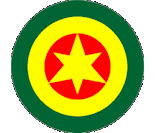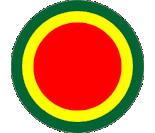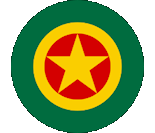1929 - Imperial Ethiopian Air Force
 Ethiopian military aviation dates from 1929, when Tafari Mekonnen (before he came to the throne as Haile Selassie) hired two French pilots and purchased four French biplanes. The history of military flying in Ethiopia dates back to 18 August 1929, after the Emperor Selassie was impressed by exploits of Huber Fauntleroy Julian, an African American and the first black person to obtain pilot’s licence in the USA. when a small flying branch of the Ethiopian Army was established at Bishoftu, near Addis Ababa.
Ethiopian military aviation dates from 1929, when Tafari Mekonnen (before he came to the throne as Haile Selassie) hired two French pilots and purchased four French biplanes. The history of military flying in Ethiopia dates back to 18 August 1929, after the Emperor Selassie was impressed by exploits of Huber Fauntleroy Julian, an African American and the first black person to obtain pilot’s licence in the USA. when a small flying branch of the Ethiopian Army was established at Bishoftu, near Addis Ababa.
Initially equipped with six Potez 25A2 biplanes, reinforced by two Junkers W.33Cs, delivered on 5 September of the same year, the Imperial Ethiopian Aviation (IEA) was put under command of a French pilot, Andre Maillet, and mainly tasked with transport and liaison duties. Maillet was succeeded by another Frenchman, Paul Corriger, in 1930, when the number of available airframes was increased by addition of a Breda Ba.15 and Ba.25 each, a DeHavilland D.H.60 Gipsy Moth, and two Fairman F.192s. By the time of the Italian invasion of 1935, the air force had four pilots and thirteen aircraft.
The beginning of Mussolini’s conquest of Ethiopia marked an outrage in the Black American community. The Ethiopians handed the Italians a humiliating defeat, but immediately suffered reprisal air bombings. Few reliable records are available from the time about Ethiopian aerial operations. It is certain that the IEA had no combat aircraft or combat-trained national pilots at the time of Italian invasion.
No Black Americans served on the ground, but two of the planes the composed the Ethiopian Air Force were flown by two Black Americans: John Robinson and Hubert Julian. The planes were used only for transportation of materials and medical supplies. John Robinson left Chicago in 1935 to fly for the Ethiopian air force after the country was invaded by fascist Italy, and his triumphant return to Chicago in 1936 gained wide media coverage.
Robinson also brought many young students to Chicago from Ethiopia for flight training. After World War II, he returned to Ethiopia to establish the Ethiopian Air Force Training Program. Later, Robinson also established a small air service, which became the forerunner of the modern Ethiopian Air Lines.
After World War II, Haile Selassie authorized the expansion of the air force. In 1947 he named a Swedish general as air force commander and contracted for a Swedish training team, equipped with eighteen Saab trainers and two squadrons of Saab-17 light bombers, to develop the air force. A Swedish officer commanded the air force until 1962, at which time Brigadier General Asefa Ayene assumed command.
In Tropical Africa only Ethiopia, Ghana, and more recently Nigeria had air forces of any size in the 1960s. The main aircraft producers and vendors had been fairly restrained in their sales activities in Africa, and military aid in the form of aircraft had not been notable. There seemed to be a tacit agreement among arms suppliers that expensive, high-performance military aircraft are not suitable or desirable for African states. The principal exception to this is Ethiopia, where the US had provided significant training and equipment to the Imperial Ethiopian Air Force (IEAF).
The 1953 United States-Ethiopian Mutual Defense Assistance Agreement resulted in the delivery of a squadron of F-86 jet fighters in 1960. In the 1960s Ethiopia had a small, versatile air forces that concentrated on logistical support, patrol, and disaster duty. By 1968 Ethiopia, with 70 aircraft, had a large inventory by African standards: a squadron of F-86s, 5 T-33s, 10 C-47s, 7 F-5s, and 20 Saab-17s and 91s.
During the 1960s and in the early 1970s the EtAF was supplied enough Sabres to form a total of five squadrons equipped with them, including the 1st, 2nd, 3rd, and 4th FIS, as well as the 5th FBS. The 1st and 2nd FIS were re-equipped with MiG-21s in late 1977, the 4th converted to MiG-17s at the same time, while the 3rd FIS continued operating Sabres well into the 1980s. Beginning in 1966 and continuing until the early 1970s, the United States delivered Northrop F-5A/B/E fighters, which became the mainstays of the air force until the late 1970s. By 1976 Ethiopia had purchase of A-37 aircraft under active consideration, with US encouragement. But it was an offensive weapon and the US had never sold attack aircraft to an African country. Ten F-5A/B aircraft were acquired through MAOP resources as a substitute.
Beginning in 1977, the Soviet Union supplied aircraft and instructors to Ethiopia. Finding a greater advantage in aligning itself with a large country in the African Horn - namely Ethiopia - Moscow agreed to supply weapons for this enterprise, conditioning these on Ethiopia providing bases for Soviet activities in Africa and the Middle East. For some time the Soviets thus found themselves supplying weapons to two countries that were in war with each other, then they were already selling MiGs and tanks to the Somalia as well.
When Moscow put Addis Ababa under pressure to repay massive loans from the USSR, the EtAF was eventually forced to sell remaining intact F-5As and F-5Es to Iran, in order to pay back some of its debts. The EtAF was unable to purchase spare parts for this type, and most of remaining airframes were meanwhile in poor condition. While few were kept flyable with help from Socialist Republic of Vietnam (which had inherited a large number of F-5As with the fall of the South Vietnam, in 1975), by the mid-1980s even Hanoi was asking for hard currency in exchange for parts – and the Ethiopians lacked the money. With all the surviving 14 F-5A/Bs and eight F-5Es being in condition that left no hope for refurbishment, Addis Ababa put them up for sale. Iran eventually obtained eight F-5E airframes, eight F-5As and two F-5Bs. Most of these could not be repaired any more and were broken down to be used as sources of spares.
By mid-1980s, the surviving Ethiopian F-5s and F-86s (operated by the 1st and 5th Sqn during the 1960s and 1970s, respectively) were little more than wrecks. The Soviets – encouraged by the Derg ability to pay back at least parts of the loans – delivered additional MiG-23BNs and MiG-21bis', as well as few MiG-21RFs to the EtAF. But on 14 January 1986, the EPLF launched a raid against Asmara AB, hitting especially hard. This time the Eritreans claimed destruction of no less but 42 aircraft and helicopters, although this claim is almost certainly exaggerated. By late 1991, most of the remaining 36 MiG-23BNs, some 20 MiG-21MFs or any of ten An-12Bs and one An-26 were in poor condition and only the aircraft and helicopters flown outside of Ethiopia - and subsequently returned - could have been described as "flyable“.
There was a strong case to be made for air force civic action to parallel the civic-action programs pursued by some African armies. The Imperial Ethiopian Air Force had already become involved in this sort of program. The small air forces can be used in crop spraying and insect eradication. The Ghana Air Force used helicopter sprayers to combat mosquitoes in the Accra area. The Imperial Ethiopian Air Force sent graduate pilots to the East African Locust Service, and it participated in the Somali Flood Relief Operation in 1961.
1977 - Ethiopian Air Force
 Ethiopia had been ruled since February 1977 by Mengistu Haile-Mariam, chairman of the ruling military council. He has moved the country along a Marxist-Leninist path and was one of the Soviet Union's firmest supporters in black Africa. Ethiopia established a Marxist-Leninist party in 1984. The influence of the party had grown since its formation, according to the US Embassy, and political cadre are tasked to indoctrinate the population in the new ideology. The regime is using the famine and drought to force peasants onto collective farms in an effort to break their resistance to government control and to facilitate political indoctrination.
During the Ogaden War, the air force quickly destroyed its Somali counterpart. By the late 1980s, the air force had become vital to the Mengistu regime's war effort in northern Ethiopia. According to an Eritrean People's Liberation Front (EPLF) spokesman in the United States, the air force was almost singlehandedly preventing the EPLF from expelling the army from Eritrea. In fact, most rebel organizations in north-central Ethiopia confined their activities to night time because of the daytime threat posed by the air force.
Ethiopia had been ruled since February 1977 by Mengistu Haile-Mariam, chairman of the ruling military council. He has moved the country along a Marxist-Leninist path and was one of the Soviet Union's firmest supporters in black Africa. Ethiopia established a Marxist-Leninist party in 1984. The influence of the party had grown since its formation, according to the US Embassy, and political cadre are tasked to indoctrinate the population in the new ideology. The regime is using the famine and drought to force peasants onto collective farms in an effort to break their resistance to government control and to facilitate political indoctrination.
During the Ogaden War, the air force quickly destroyed its Somali counterpart. By the late 1980s, the air force had become vital to the Mengistu regime's war effort in northern Ethiopia. According to an Eritrean People's Liberation Front (EPLF) spokesman in the United States, the air force was almost singlehandedly preventing the EPLF from expelling the army from Eritrea. In fact, most rebel organizations in north-central Ethiopia confined their activities to night time because of the daytime threat posed by the air force.
- Ethiopian Air Force
 On 24 December 2006 Ethiopian forces launched airstrikes as part of a counterattack against Islamist fighters in neighboring Somalia. Ethiopia's information minister (Berhan Hailu) said operations targeted several Islamic militia strongholds (Dinsoor, Bandiradley, Baladwayne, Buur Hakaba) along Ethiopia's border. It was the first time Ethiopia had acknowledged its military is fighting in Somalia. Witnesses in central and northern Somalia reported warplanes bombarding Islamist positions and Ethiopian ground troops exchanging mortar fire with Islamist forces. Heavy fighting was also reported near the transitional government headquarters in Baidoa.
On 24 December 2006 Ethiopian forces launched airstrikes as part of a counterattack against Islamist fighters in neighboring Somalia. Ethiopia's information minister (Berhan Hailu) said operations targeted several Islamic militia strongholds (Dinsoor, Bandiradley, Baladwayne, Buur Hakaba) along Ethiopia's border. It was the first time Ethiopia had acknowledged its military is fighting in Somalia. Witnesses in central and northern Somalia reported warplanes bombarding Islamist positions and Ethiopian ground troops exchanging mortar fire with Islamist forces. Heavy fighting was also reported near the transitional government headquarters in Baidoa.
The airstrikes mark an apparent escalation in days of fighting that both sides claim has caused hundreds of casualties. The tally was not independently confirmed.Ethiopian fighter jets bombed parts of the main airport in Somalia's capital Mogadishu and a second airport held by the Somali Islamist movement about 100 kilometers to the west.
In 2008 the Ethiopia Air Force used its one operational C-130 to transport its peacekeepers to peacekeeping missions in Africa. Ethiopia had peacekeepers in Liberia and was deploying to Darfur. Enhancing Ethiopian air transport capability reduced requirements on US airlift to move African peacekeeping forces in the region. Lastly, having operational transport aircraft enhances the capability of the Ethiopian Air Force to respond to humanitarian crises (drought and/or flooding) in the Ogaden region and elsewhere in Ethiopia, specifically humanitarian relief supplies and food.
|
NEWSLETTER
|
| Join the GlobalSecurity.org mailing list |
|
|
|

